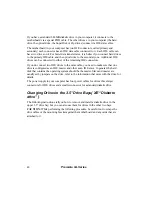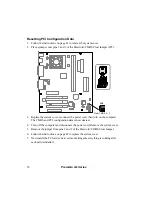
48
Premmia GL Series
If you have a standard 1.44MB diskette drive in your computer, it connects to the
motherboard via a special FDD cable. The other drives e in your computer (the hard
drive, the optical drive, the SuperDisk or Zip drives) connect via IDE data cables.
The motherboard in your computer has two IDE connectors, called primary and
secondary; each connector has an IDE data cable connected to it. Each IDE cable can
have two drives on it. For faster data transfer rates, it is better if you connect hard drives
to the primary IDE cable, and the optical drive to the secondary one. Additional IDE
drives can be connected to either of the remaining IDE connectors.
If you do connect two IDE drives to the same cable, you need to make sure that one
drive is configured as an IDE master and other as an IDE slave. In general, the hard
disk that contains the operating system should be the master. Slave and master are
usually set by jumpers on the drive, refer to the information that came with the drive for
details.
The power supply in your computer has four power cables for drives: three larger
connectors for IDE drives and a smaller connector for a standard diskette drive.
Changing Drives in the 3.5” Drive Bays{ XE “Diskette
drive” }
The following instructions tell you how to remove and install a diskette drive in the
upper 3.5” drive bay, but you can also use them for drives in the other two bays.
CAUTION:
While performing the following procedure, be careful not to scrape the
drive cables or the mounting bracket against the motherboard and any cards that are
attached to it.
















































